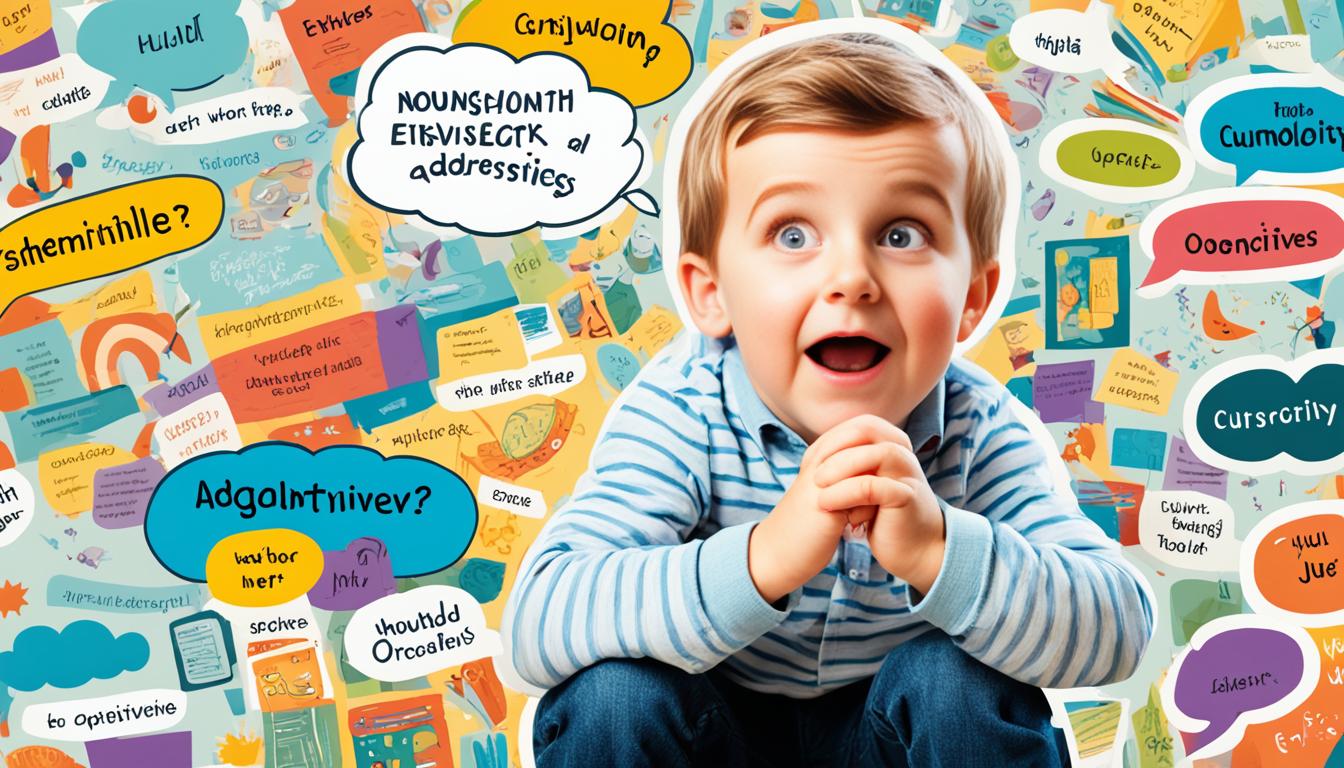The Process of Child Language Acquisition: Understanding and Support
Child language acquisition is a fascinating journey that shapes a child’s ability to communicate and express themselves effectively. As a parent or caregiver, it is crucial to comprehend the stages of language development in children and provide the necessary support to facilitate their language learning.
From infancy through childhood, children undergo a remarkable transformation in their language skills. They progress from babbling and uttering single words to constructing sentences and expressing complex thoughts. Genetic factors, the surrounding environment, and social interactions all play a role in shaping a child’s language development.
Key Takeaways:
- Child language acquisition is a complex process that begins in infancy and continues throughout childhood.
- Understanding the stages of language acquisition can help parents and caregivers create a language-rich environment.
- Language milestones, such as babbling and one-word utterances, mark the progression of language development in children.
- A language-rich environment, including talking, reading, and engaging in meaningful conversations, can enhance children’s language learning.
- Fostering social interactions and exposing children to diverse language models can optimize their language development.
Stages of Child Language Acquisition
Child language acquisition progresses through various stages, each marked by specific language milestones. It is important to understand these stages to track and support a child’s language development effectively.
1. Prelinguistic Stage:
During this stage, infants communicate through gestures, facial expressions, and vocalizations. While they are not yet producing recognizable words, they use non-verbal cues to convey their needs and desires.
2. Babbling Stage:
Babies experiment with different sounds and syllables during the babbling stage. This is an essential phase where they explore the capabilities of their vocal cords and begin to imitate the sounds they hear around them.
3. One-Word Stage:
As children approach their first birthday, they enter the one-word stage. In this phase, they begin using single words to express their thoughts and communicate their needs. This milestone is significant as it represents the transition from simple to more complex language.
4. Two-Word Stage:
Children progress to the two-word stage as they continue their language development. They start combining words to form simple sentences and express more complex ideas. This stage indicates their growing understanding of grammar and syntax.
5. Vocabulary Expansion:
As children grow older, their vocabulary expands, and they develop a more extensive repertoire of words. They learn new words through interactions, reading, and exposure to different environments. This phase also involves developing a deeper understanding of grammar rules, sentence structure, and pragmatics.
6. Advanced Language Skills:
In the later stages of language acquisition, children refine their language skills further. They become proficient in using more complex grammar structures and communicating their thoughts and ideas effectively. Their language development continues as they refine their abilities to understand and express themselves in a variety of contexts.
It is important to note that every child’s language development journey is unique, and they may reach these milestones at different ages. Monitoring a child’s progress and providing appropriate support can help ensure healthy language development.

| Stage | Characteristics |
|---|---|
| Prelinguistic Stage | Gestures, facial expressions, vocalizations |
| Babbling Stage | Experimentation with sounds and syllables |
| One-Word Stage | Usage of single words to convey meaning |
| Two-Word Stage | Combining words to form simple sentences |
| Vocabulary Expansion | Growing vocabulary and understanding of grammar |
| Advanced Language Skills | Proficiency in complex grammar and effective communication |
Understanding the stages of child language acquisition provides valuable insights into a child’s language development journey. It helps parents, caregivers, and educators create environments that foster optimal language learning and support children in reaching their full linguistic potential.
Fostering Language Development in Children
Creating a language-rich environment is essential for supporting child language acquisition. Providing ample language stimulation through talking, reading, and singing to children from an early age can significantly enhance their language development.
According to experts cited in Third source, engaging in meaningful conversations, using descriptive language, and exposing children to a wide variety of words and concepts can help expand their vocabulary and promote language learning. Additionally, reading books with children and encouraging them to ask questions and express their thoughts can foster their literacy skills and cognitive development.
Creating opportunities for social interactions with peers and individuals of different ages can also contribute to language development by providing children with diverse language models and opportunities to practice their communication skills. Overall, a supportive and language-rich environment can play a crucial role in optimizing child language acquisition and helping children develop effective communication skills.
FAQ
What is child language acquisition?
Child language acquisition refers to the process by which young children develop communication skills and learn language. It involves the stages of language development and the factors that influence this process.
At what age does language acquisition begin?
Language acquisition begins in infancy, soon after birth. Infants start communicating through gestures, facial expressions, and vocalizations, which eventually develop into more complex language skills.
What are the stages of child language acquisition?
Child language acquisition can be divided into several stages, including the prelinguistic stage, babbling stage, one-word stage, two-word stage, and eventually the development of advanced language skills.
How can I support my child’s language development?
Creating a language-rich environment is essential to support your child’s language development. You can do this by engaging in meaningful conversations, reading books together, and exposing your child to a wide range of words and concepts.
What factors influence child language acquisition?
Child language acquisition is influenced by various factors, including genetics, the environment in which the child grows up, and social interactions. These factors can impact the pace and trajectory of language development.
Is every child’s language development the same?
No, every child’s language development is unique. While there are general milestones and stages of language acquisition, children may reach them at different ages. It is important to monitor their progress and provide appropriate support based on their individual needs.
Source Links
- https://www.theguardian.com/world/live/2024/feb/11/middle-east-crisis-live-international-warnings-mount-ahead-of-planned-rafah-offensive
- https://www.insidermonkey.com/blog/15-careers-that-bilinguals-and-multilinguals-will-excel-in-1257058/
- https://apnews.com/article/finland-presidential-election-runoff-stubb-haavisto-545f7942ec9855152c4d9ac8dc840c10






